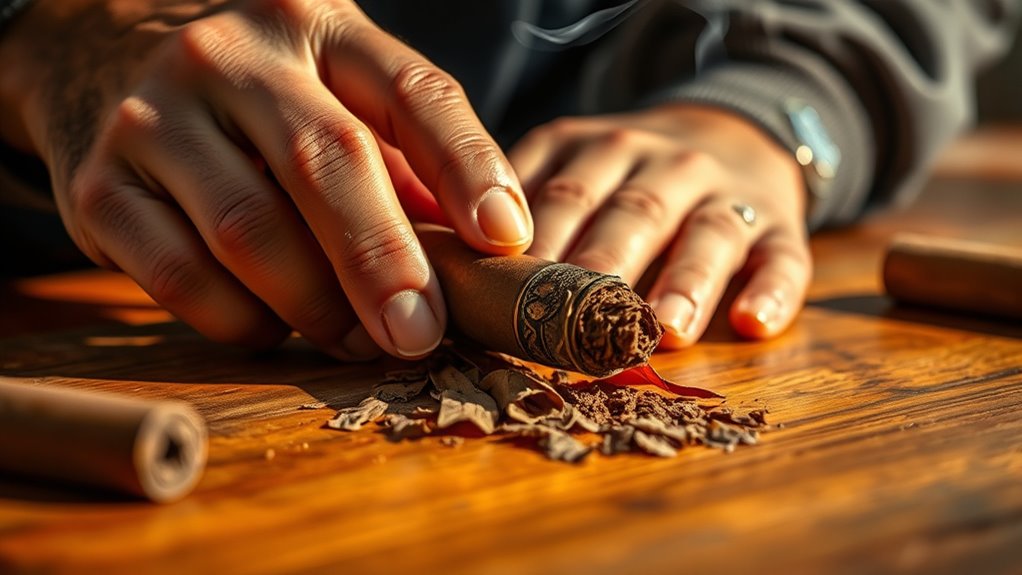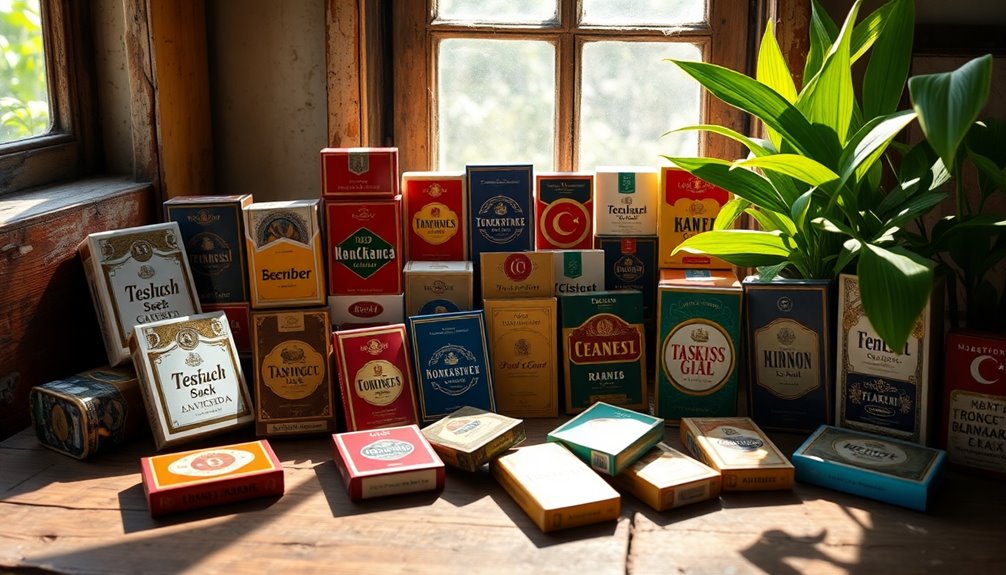To craft hand-rolled cigars, you select and blend different tobacco leaves to create a balanced flavor, paying attention to origin, curing, and leaf position. You develop techniques for preparing, rolling, and finishing your cigars with consistent tension and proper moisture to guarantee an even burn and ideal airflow. Your skill improves with practice, allowing you to personalize each cigar for a satisfying experience. If you keep exploring, you’ll uncover the secrets behind perfecting every puff.
Key Takeaways
- Proper preparation of tobacco and wrapper leaves ensures a smooth, even burn and optimal flavor during rolling.
- Mastering consistent tension and pressure creates uniform cigars with balanced draw and aroma.
- Blending different tobacco leaves allows customization of flavor profile, strength, and complexity.
- Attention to finishing touches like tucking the cap and applying slight pressure enhances cigar quality.
- Practice and patience develop craftsmanship, turning beginners into skilled cigar artisans.

Hand-rolled cigars have long been prized by enthusiasts for their craftsmanship and rich flavor. When you immerse yourself in the world of making your own cigars, you quickly realize that the process is both an art and a science. One of the most critical aspects is cigar blending, where you select and combine different tobacco leaves to create a unique flavor profile. You’ll find that blending isn’t just about choosing your favorite types of tobacco; it’s about balancing strength, aroma, and complexity. A skilled blender considers the origin, curing process, and leaf position within the cigar to craft a harmonious experience. As you experiment, you’ll learn how certain leaves complement others, enhancing subtle notes or adding boldness where needed. Mastering cigar blending allows you to personalize your smokes, turning each cigar into a reflection of your taste.
Once you’ve chosen your blend, the next step is perfecting your rolling techniques. You might think that rolling cigars is simple, but it’s a precise skill that requires patience and practice. You start by carefully preparing your tobacco, ensuring it’s evenly shredded and moist enough to handle without tearing. When you begin to roll, you’ll focus on maintaining consistent tension and shape, so the cigar burns evenly and draws smoothly. The way you handle the wrapper leaf is especially important—you want it tight enough to hold everything together but loose enough to allow airflow. As you roll, you’ll develop a feel for how much pressure to apply and how to keep the cigar uniform in size. Over time, your rolling techniques improve, resulting in a cleaner, more professional-looking cigar that burns evenly and produces a satisfying draw. Many cigar makers also pay close attention to the finishing touches, like tucking the cap and applying a slight pressure to ensure everything stays in place.
Getting comfortable with cigar blending and rolling techniques transforms you from a beginner to a craftsman. You’ll notice that each step influences the overall experience, from aroma to burn quality. The more you practice, the better your cigars will become, and you’ll develop your own signature style. Whether you prefer a bold, full-bodied smoke or something more nuanced and mellow, your hands-on approach ensures every cigar is tailored to your preferences. Making your own cigars isn’t just about creating smoke; it’s about appreciating the craftsmanship behind each puff. With patience and dedication, you’ll find that crafting hand-rolled cigars becomes a rewarding ritual, elevating your enjoyment of this timeless tradition. Additionally, understanding grocery savings strategies can help you allocate more resources towards premium tobacco leaves, enhancing your blend quality.
Frequently Asked Questions
What Are the Best Tobaccos for Hand-Rolled Cigars?
When choosing the best tobaccos for hand-rolled cigars, focus on flavor profiles and cultivation regions. Nicaraguan tobacco offers bold, spicy notes, while Dominican tobaccos provide smooth, mellow flavors. Connecticut shade-grown leaves bring subtle sweetness, and Maduro varieties add richness. Your choice depends on the flavor profile you desire, so explore regions like Honduras, Cuba, and the Dominican Republic to find tobaccos that match your preferred taste and aroma.
How Do I Start Learning to Roll Cigars at Home?
To start learning cigar rolling techniques at home, you should first gather beginner cigar kits, which include essential tools and instructions. Practice consistently, focusing on your hand movements and filling techniques. Watch tutorials online and join cigar enthusiast communities for tips and feedback. Patience is key; as you practice, your skills will improve. Remember, mastering cigar rolling takes time, so enjoy the process and don’t rush your progress.
What Tools Are Essential for Hand-Rolling Cigars?
Did you know that mastering traditional cigar tools can improve your rolling skills considerably? To get started, you’ll need essential cigar rolling tools like a cigar mold, a sharp knife, and a tamper. These tools help you control the cigar’s shape and ensure a smooth roll. Focusing on traditional cigar tools and techniques will make your hand-rolled cigars look professional and enhance your overall experience.
How Do I Store Cigars to Maintain Their Quality?
To keep your cigars fresh and flavorful, you should focus on humidity control. Store them in a humidor with a consistent humidity level of around 70%, which helps maintain their quality. Proper storage also supports the aging process, enhancing flavor over time. Keep your cigars away from direct sunlight and temperature fluctuations, and check the humidity regularly to guarantee they stay in perfect condition for when you’re ready to enjoy them.
Are Hand-Rolled Cigars More Affordable Than Machine-Made Ones?
Think of hand-rolled cigars as a finely woven tapestry; their price reflects the craftsmanship behind each thread. Generally, they’re more expensive than machine-made cigars due to higher production costs, which include skilled labor and meticulous attention to detail. While they may cost more upfront, many enthusiasts value the artistry and quality, making the cost comparison worth it. Ultimately, you pay for the passion woven into every hand-rolled cigar.
Conclusion
So, as you master the art of hand-rolling cigars, remember you’re not just crafting a smoke—you’re weaving a story, a delicate dance of passion and patience. Each cigar is like a tiny vessel carrying your dedication and skill, ready to deliver moments of pleasure. Embrace the process, and let your craftsmanship be the flame that ignites your love for this timeless tradition. In this art, you’re creating more than a cigar—you’re crafting an experience.










